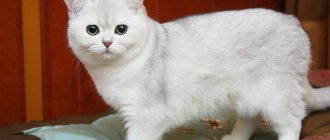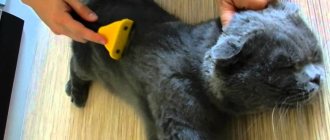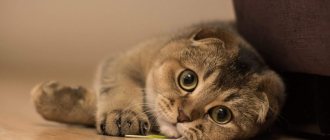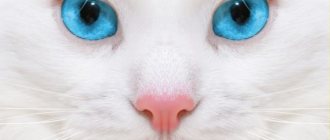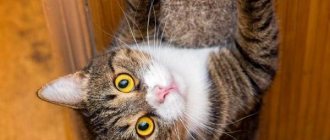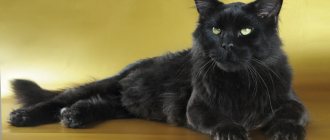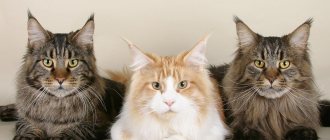The Amur forest cat is the closest relative of the more famous Bengal cat, which lives a little further south. Very little is known about these inhabitants of the taiga. Amur cats are listed in the Red Book as an endangered species. Scientists cannot say how true this is. In fact, the animal was included in the red list only because there is no accurate data on its number.
Appearance of the Amur forest cat
The Amur forest cat is a subspecies of the wild Bengal cat. Compared to other wild felines, it is small in size and only slightly larger than domestic cats. Males are larger than females, on average they weigh about 6-8 kg, but some individuals can reach 15 kg. You can see what an Amur cat looks like in the photo.
The body length is 60-90 cm, with a third of the total length coming from the tail. In some representatives of this subspecies the tail reaches 40 cm in length. Cats have a strong, muscular body with long, strong legs. The toenails are small but strong and easily retract into the pads.
Compared to the body, the head is small and round. The eyes are quite large, located close to each other, and the forehead is high. The ears are small, set wide apart; Amur cats do not have tufts at the tips of their ears, which are characteristic of many wild cats. The nose is wide and flat, with a brown nose. The pads under the vibrissae are plump and clearly defined. In the mouth there are long, sharp and thick fangs, which allow the animal to tear even tough and old meat.
https://youtu.be/2IC58diLFs0
What does it look like?
The Amur cat looks like the familiar domestic cat, although it belongs to a different subspecies. The length of its body is about 90 cm, almost half of which is the tail. Female animals are smaller than males, their body weight does not exceed 4 kg. Males, in turn, weigh approximately 8 kg. The inhabitant of the Far East boasts a muscular and flexible body, long limbs, a small head on which rounded ears are located. There are also such notable features:
- The eyes are close and deep-set.
- There is a stripe running down the middle of the nose, which is practically not covered by fur.
- The claws are short, and the fangs, on the contrary, are long.
Animal color
The color of the fur of the cubs of such an animal is close to leopard.
The Amur cat has a thick undercoat and soft fur. The color is gray-sand or yellow-brown. The body is decorated with red spots, which form 3 stripes on the back. They are also located on the limbs and throat. Kittens are more reminiscent of a leopard; in older individuals, the coloring becomes more even. The fur on the belly is lighter than on the back. There are also stripes on the head that start from the inner corners of the eyes. Thanks to this color, wild cats can hide unnoticed both on the ground and in trees.
Captivity
Like other wild cats, the Amur forest cat is very difficult to tame. In addition, he is characterized by secrecy, which prevents him from joining human society. It is worth saying that no one really tried to tame them. Amur cats are unremarkable and have failed to interest cat lovers.
Some zoos keep Amur cats.
In captivity, animals reproduce well, but they continue to be wary of people. If someone still wants to have an Amur cat, they will have to keep it in a fairly spacious enclosure. You can feed small rodents and poultry once a day.
Life with a man
But, despite the fact that keeping Amur cats at home and buying and selling transactions are prohibited, and failure to comply with this ban is subject to a fine of up to a million rubles.
This does not stop some, and exotic lovers strive to acquire an unusual predatory cat, challenging their wild nature. From time to time there are advertisements for the sale of such cats, the price for them reaches one hundred thousand rubles, but keeping such a pet will cost even more. In such cases, it is necessary to remember that his predatory nature will not go away and will not become an affectionate kitten, and sometimes this can even become dangerous.
If you still manage to get such a cat at home, you need to follow some recommendations.
- Create a free enclosure for the cat, with equipment for jumping and climbing.
- Feed your pet once a day, preferably at the same time.
- The diet should include poultry, lean beef, veal and rabbit, and don’t forget about mice.
- Sometimes you can give your pet fish, boiled vegetables and eggs.
- Once a week, do a fasting day for the cat.
- Provide the cat with toys: balls, mice.
It has been proven that even if you take a newly born kitten and try to tame it, nothing will work, the hunting instincts will make themselves felt, and the animal will want to go into the wild. Even after a long stay in captivity, the cat will be able to easily adapt to the forest and will not disappear.
The Amur forest cat is a unique subspecies of the cat family. Nature has rewarded it with an unusual coloring, tenacious paws, a strong body and a death grip. Listing in the Red Book protects the cats’ habitat and species. Despite warnings and fines, they still try to domesticate wild cats, sometimes without creating the necessary living conditions and putting themselves in danger.
Feeding in captivity
The main food of the Far Eastern forest cat in captivity is lean meats, such as beef, but without live food - rats, mice, day-old chicks and quails, it is difficult to maintain normal physiological activity and reproduction of animals, especially since the behavioral characteristics of the predator are dulled, which leads to " obsessive movements”, boredom of the animal. In addition, the animal eats not only fresh meat, but also the contents of the intestines, the brain, and part of the skin with wool (feather) of “live” food. It is believed that to complete protein metabolism, it is advisable to offer fish once a week. But not all the time. Excess fish in the diet can lead to the leaching of calcium from the animal’s body and, accordingly, to associated diseases, such as rickets.
For daily feeding of a Far Eastern forest cat, 2 mice, or one rat and about 200 grams are enough. lean meat. Feed once a day.
An equally important component of feeding is a weekly fasting or “fasting” day, when the animal (except for females during lactation and kittens up to six months of age) is not given meat or live food. However, some experts, once a week, in addition to the “hungry” day, arrange a “half-starved” day, when the norm of meat or live food is given at half the norm
This is important, since in captivity cats do not spend energy as intensively as in the wild and therefore often get fat, get sick and even die
This is important, since in captivity cats do not expend energy as intensively as in the wild and therefore often become fat, get sick and even die. When keeping cats indoors, in good weather it is necessary to periodically walk them outdoors. On the street, the cat receives natural ultraviolet light (which is extremely necessary for the production of vitamin D, which in turn has a positive effect on health), feeds on meadow grass (looking for the necessary herbs for the body), and gets acquainted with new smells
Walking “domestic” cats is important for the full physical and psycho-emotional development of the animal
On the street, the cat receives natural ultraviolet light (which is extremely necessary for the production of vitamin D, which in turn has a positive effect on health), feeds on meadow grass (looking for the necessary herbs for the body), and gets acquainted with new smells. Walking “domestic” cats is important for the full physical and psycho-emotional development of the animal
When keeping cats indoors, in good weather it is necessary to periodically walk them outdoors. On the street, the cat receives natural ultraviolet light (which is extremely necessary for the production of vitamin D, which in turn has a positive effect on health), feeds on meadow grass (looking for the necessary herbs for the body), and gets acquainted with new smells. Walking “domestic” cats is important for the full physical and psycho-emotional development of the animal.
Life expectancy in captivity is 20 years.
Animal color
The wild Far Eastern cat stands out among its relatives with its thick and long fur. The villi on the body of an adult can reach 5 cm in length. This coat allows him to live in harsh climatic conditions. In the fall, the cat sheds, its fur becomes thicker and longer, and in the spring shedding occurs again.
The reddish-brown color makes the cat almost invisible among the trees. The back of the animal is darker than the belly, the color varies from gray-yellow to gray-brown. There are 3 dark brown stripes running along the cat’s spine; in some animals they merge into one wide stripe. There are 4-5 transverse thin stripes of a reddish hue on the neck. Stripes also decorate the cat's face and paws.
The long thin tail is usually plain, red or brown. However, in some representatives of the species it is colored with gray and black stripes.
Origin story
According to the latest scientific data, wild cats appeared during the Pleistocene period, which ended approximately 11,700 years ago and was characterized by extremely harsh climatic conditions. The alternate advance and retreat of glacial masses on the world's continents caused abrupt climate change, which served as the impetus for a strong intensification of speciation processes. This led to the generation of a wide variety of new forms in the animal and plant world, more adapted to real living conditions (woolly rhinoceroses, mammoths, giant deer, cave lions, etc.). Not all animals were able to adapt to the constantly changing climate; many became extinct. But the cats succeeded, they mastered dense forests and highlands for living.
Wild cats have lived on earth for almost 12 thousand years
Scientists believe that the domestication of cats occurred when people took up farming and began to lead a sedentary life. They stored grain crops, which attracted many rodents. Which, in turn, became easy prey for cats.
Security measures
There is no exact data on the number of individuals of Amur cats. Due to their secrecy, it is impossible to make even an approximate calculation. Despite this, the Far Eastern forest cat is listed in the Red Book of the Russian Federation.
The main threats to this feline include weather conditions, habitat loss and interbreeding with domestic cats. To save forest cats, measures are being taken to protect them in the form of a complete ban on fishing and random capture. Also, extensive explanatory work is being carried out among hunters and the population about the significance and importance of preserving this species in the list of territorial fauna. It is known that in recent years their population has begun to increase.
We invite you to read: Caraquet - cat or lynx: secrets of the breed
Varieties
In the natural world there is a wide variety of species of wild cats that live in different parts of the vast planet. Many species of big wild cats are listed in the Red Book, as there is a threat of extinction. The names of wild cats are different, but they are united by one cat genus.
Caucasian
The Caucasian forest cat lives in the Caucasus mountains at an altitude of up to two kilometers, the number of individuals is only 100. As a result, the species is included in the Red Book.
The color is dominated by brown shades - the skin is reddish-brown with gray leopard spots. The wild Far Eastern cat prefers night hunting and impenetrable wilds and thickets.
Amursky
The Amur cat is a type of Bengal cat. It has thick grayish-brown fur with dark red spots. It lives along the Amur River and near the Sea of Japan. He is also known as the Far Eastern forest cat.
Reed
This Russian forest cat is found in the Astrakhan region of Russia. External characteristics greatly distinguish it from other forest wild cats.
This animal has powerful paws, a small tail and large ears, at the tip of which there are small tassels reminiscent of the tassels of a lynx. In this regard, it is also called the “swamp lynx”. As can be seen from the second name, it prefers reed thickets along rivers and swamps.
Although the places where swamp lynxes live are located near human habitation, they are quite suspicious and do not approach people. This species of cat is listed in the Red Book.
But since catching a European forest cat is a rather difficult task, the survival of the species is guaranteed by the presence of trees on which wild cats climb well.
Habitats of the Amur forest cat
Amur forest cats live in the Far East, in the Amur River basin and along the coast of the Sea of Japan. A small population lives on the island of Tsushima, where the animal is called the Tsushima cat.
If previously representatives of this subspecies inhabited all of Primorye, Khabarovsk Territory, Transbaikalia, now the population has decreased significantly. This was due to human activity. The habitat has decreased due to plowing of virgin lands, uprooting of bushes, and burning of forests. Many animals died in traps, and for a long time these cats were considered enemies of agriculture along with wolves, and they were deliberately exterminated.
At the moment, the Amur leopard cat is listed in the Red Book of the Primorsky Territory. High fines are imposed for killing an animal. According to rough estimates, there are only 2-3 thousand individuals left in the world. There are about fifty of them living in Japan. Now the animal is found mainly in nature reserves - Bolshekhehtsirsky, Khankaysky, Ussuriysky, Kedrovaya Pad, Lazovsky.
Population status
Currently, the Amur forest cat is included in the Red Book. The exact number of cats of this subspecies is unknown today. According to rough estimates, it does not exceed two and a half to three thousand individuals.
According to the generally accepted point of view, the number of Amur cats has decreased by at least a third. Part of the responsibility for the sharp decline in wild cats lies with humans themselves, as they are involved in:
- plowing virgin soil;
- cutting down bushes;
- setting fire to stakes (small forests in the fields).
Many representatives of the subspecies fell into hunting traps and snares, originally intended for hares. Uncontrolled natural fires also played a destructive role.
All the negative factors described above led to the fact that in 2015 there were only a few thousand Amur forest cats.
Prevention of extermination
Thanks to the efforts of animal rights activists, a significant fine was introduced for the destruction of Amur cats, reaching several thousand rubles. In the near future, it is planned to systematically inform local residents, especially hunters, about rare representatives of the local fauna, as well as about the usefulness of wild cats in the fight against rodents. Also, Far Eastern cats are under vigilant supervision in Japan, where about fifty representatives of the subspecies live.
Reserves
It is difficult to overestimate the contribution of protected areas in the regions, which provide greater safety for animals. The list of such territories includes
- Land of the Leopard National Park;
- Kedrovaya Pad Nature Reserve;
- Bolshekhehtsirsky Nature Reserve;
- Lazovsky Reserve;
- Khanka Nature Reserve;
- Ussuri Nature Reserve.
Zoos
The Far Eastern leopard cat is a rare guest in zoos. It is mainly kept in zoos in China and Japan, but in Russia there are several places where this animal lives, for example, the Barnaul Zoo.
They say that Amur cats do not live in zoos, but simply die for a long time
There are several reasons for such a low prevalence of the Amur cat. Firstly, catching a wild cat specifically for collection is not an easy task. That is why the Amur cat was and remains one of the most poorly studied subspecies.
Secondly, leopard cats languish in captivity. Even in a zoo, where no one and nothing threatens the cat, the wild animal remains wild and extremely cautious. As a rule, he builds a hole for himself or uses an already prepared one, only occasionally coming into contact with people and other inhabitants.
When surrounded by people and other animals, cats remain withdrawn and cautious.
Despite the unadaptability of wild cats to life in a cage, in zoos and enclosures the life expectancy of representatives of the subspecies is 17-18 years, while in the wild they are given 10-12 years. However, there are a variety of assumptions about the number of years allotted to a forest cat by nature. Some argue that 18 years is not the limit.
In Primorye they say: “A harsh winter means wait for a cat.”
Winter is the most difficult period in the life of these wild cats. Having thin and short paws - this can be seen even from the photo - the Amur cat is practically unable to move through deep, loose snow. Only present day saves. If it is not there, the animals are unable to hunt and starve for weeks.
The reserve of fat that the Amur cat stores in advance in the fall helps. With an average weight of 4 kg, the animal can increase its weight to 8–9 kg, significantly changing in appearance, practically turning into a ball of fur.
Director of the Lazovsky Nature Reserve Alexander Laptev tells interesting facts: the Amur forest cat, it turns out, in especially snowy winters operates in village chicken coops, where it feeds on poultry - chickens, ducks. In particular, such cases became more frequent in March 2010, when heavy snowfalls made it very difficult for Amur cats to feed themselves.
“The Far Eastern forest cat is not dangerous for humans. As a rule, when people approach, he runs away,” says Alexander Laptev. As soon as the first warmth sets in and the snow begins to melt, the forays of Far Eastern cats into the villages stop.
Can he live at home?
Many people tried to tame the Far Eastern cat, but there were no successful attempts. It is uncomfortable for a predator to live at home; he treats owners with caution. Even if the animal was taken immediately after birth, as an adult it tends to leave its home and return to the forest. Despite this, cats are still being studied. For these purposes, they resort to a special cage in which the meat is placed. When an animal enters it to take a piece, it is caught, euthanized, and put on a collar equipped with a beacon. In this way, we obtained data on the habits and lifestyle of Far Eastern cats.
Nutrition and lifestyle
The frequency and nature of the Amur cat’s feeding depends on the time of year. In spring, summer and autumn, the animal tries to accumulate as much subcutaneous fat as possible. A cat can eat about 15-20 mice and 3-4 birds per day, despite its small size. Such a rich diet is explained by the fact that in winter a cat may not eat anything for several days or even weeks. He almost never leaves his home and waits for a rodent to accidentally run into him. Thus, over the summer the animal gains weight, and in the winter it uses fat reserves to survive the cold.
What does the Amur cat eat? The diet includes mice and other rodents, birds, snakes, hares, and muskrats. If a cat manages to defeat a roe deer or other large animal, it will happily feast on it.
How do small cats manage to catch such large mammals? The fact is that Amur cats are natural hunters who track down prey in ambush and are excellent tree climbers. They are dexterous, fast, instantly grab their prey and bite it with long fangs. They prefer to hunt at dusk, and during the day they hide in shelters. Some individuals wander into villages and steal chickens and other domestic animals.
Amur cats lead a solitary lifestyle and only in the spring, during the mating season, do they form groups. The habitat is divided between them into individual territories of 9-10 square meters. km. Animals jealously guard the boundaries of their territory and do not allow strangers in. They are tied to their place and are very reluctant to leave it only in conditions of great need due to lack of food.
Although their thick fur allows cats to live in harsh climates, they prefer rocks without snow. The fact is that Far Eastern cats cannot hunt in snow whose thickness exceeds 30-40 cm.
Representatives of this subspecies are distinguished by their intelligence. This makes them a formidable opponent - not every dog and even a wolf can cope with a small Amur cat. Cleverness is also evident in the arrangement of the home. The cat chooses difficult to pass places - rock crevices, snow-covered windbreaks, where a larger animal cannot pass. Life span is 17-18 years.
Despite the fact that these cats are formidable predators, they have natural enemies. Wolves, sables, martens, and golden eagles hunt cats, especially newborn kittens.
Habitat
The Amur cat settled along the shores of the Sea of Japan and near the Amur basin. In addition to Russia, the Far Eastern cat is common in China, Japan and the Korean Peninsula, inhabiting the entire space from Hindustan to the Malay Archipelago.
Amur cat in Primorsky Krai
Since the area inhabited by the Amur cat is large and climatically heterogeneous, the habits of wild cats from different regions may differ from each other. In particular, the habitat affects the breeding periods and the mass of cats.
Amur cats are happy to explore the steppe
The tropical orientation of the Far Eastern cat suggests that impenetrable forests are not the best place for animals like him. However, circumstances were such that the Amur cat emigrated to the snowy Ussuri region and remained to live there forever.
Lifestyle of Far Eastern forest cats
These animals can live alone or in pairs, but during the breeding season several individuals gather together. Each cat has its own individual area of 5-9 square km. These predators lead a nocturnal and twilight lifestyle. Amur forest cats are shy and mistrustful, making them difficult to detect. They attack prey from an ambush, which they set up on the ground or in trees.
The Far Eastern forest cat reaches its prey in one leap.
In winter, Amur cats migrate from the mountains to valleys and hilltops, from which snow is blown away by the wind. During severe frosts, they can approach people's homes, where they catch rodents in old buildings.
If a Far Eastern cat is in danger, it takes refuge in a tree. They make shelters in hollows, rock crevices or among dense bushes; they also happily use abandoned holes of badgers and foxes. The bottom of the den is insulated with wood dust, leaves and grass.
Amur forest cats can excellently climb trees and rocks and swim well. The predator has several temporary shelters on the site. In winter, the safest permanent housing is used.
Far Eastern forest cats feed on mouse-like rodents, chipmunks, squirrels, Manchurian hares, birds and their eggs. Sometimes they can attack larger prey, for example, young deer and roe deer.
The lifespan of Amur forest cats in nature is 8-10 years, and in captivity they can live up to 15 years.
The diet of the Amur forest cat may include frogs and insects.
Features of reproduction
The mating season begins at the end of February and continues throughout March. The forest is filled with the abrupt roar of males, who thus attract females to mate. This is the only period of time when individuals unite in pairs and retain them during the cat’s pregnancy and raising offspring.
The female bears kittens for 9-10 weeks. On average, 3-4 cubs appear per litter. Kittens are born small, blind and unadapted to independent life; the cat feeds them milk for up to 2.5 months. Their eyes open on the 10th day, cognitive activity begins at 2 months, and they will be ready for a separate life only after six months.
All this time, the cat jealously protects the offspring, because there are many enemies around who want to feast on blind kittens, for example, martens. Amur cats are good and caring parents. When danger arises, cats move their babies to a new place and hide them. Even males take part in caring for the kittens, bringing food to the babies and females.
Amur cats rarely abandon their cubs. This can only happen to primiparous females. Kittens can be picked up by ordinary domestic cats and mistaken for their own.
Due to their similar size, mating is possible between the Amur cat and a domestic cat. In this case, the kittens turn out to be wild and try to escape into the forest. Such crossbreeding can help increase the population of Amur cats.
Norwegian Forest - care and feeding
require. The Norwegian Forest cat breed needs brushing, walking, quality nutrition, necessary vaccinations, and veterinary examinations.
Pets do not need special care, and attention from the owner makes him happy. With proper care of health and nutrition, fluffies can live up to 14 years
Norwegian Forest breed - care features
Keeping pets is not a problem. The Norwegian Forest Cat has a double coat and needs to be brushed once a week. This breed sheds profusely in spring and autumn and will require daily grooming. The pet's fur does not get tangled or matted. The giant needs its ears and teeth cleaned and its claws trimmed. The pet loves to climb into cabinets - it is better to buy him a tall house or stand for this. The health of the forest species is excellent. But they are predisposed to diseases of the skeletal system. They should have a cardiogram regularly to avoid heart disease.
Norwegian Forest Cat – mating
Estrus in animals begins late, as in most large breeds. Mating can be planned for estrus 3-4. Until that period, the body cannot cope with the load of bearing fruit. The Norwegian Forest cat breed tolerates pregnancy favorably due to its strong health and large size. Childbirth in such animals proceeds normally - 3-6 kittens are born.
Nutrition of the Norwegian Forest Cat
The long-haired beauty needs 300-500 Kcal per day, which corresponds to 70-120 grams of good quality dry food. When organizing a diet with natural products, you need to take into account that your pet is a predator and needs a lot of protein food. Also, such a large pet should not be overfed. Norwegian Forest Cat – nutrition description:
- scalded or raw frozen lean meat (veal, beef);
- boiled offal;
- fish;
- eggs;
- dairy products;
- cereals (buckwheat, rice);
- vegetables;
- sprouted cat grass to provide vitamins and cleanse the stomach.
Norwegian Forest kittens - care rules
The purebred babies are healthy and playful. The Norwegian Forest Cat has adult fur at 3-5 months. Caring for babies involves taking care of physical development, proper nutrition, fur, and vaccinations. You can feed them lean chicken, turkey, and beef. You need to add cottage cheese and offal to your diet. Fish without bones can be given once a week
It is important to accustom kittens to cleanliness and hygiene - install a tray in a secluded place and force the baby to go to the toilet only in it. Pets are combed once a week, and hair removal paste is added to the food.
The Norwegian Forest Cat is a fluffy beauty of considerable size. With a wild pedigree, the pussycat exhibits a calm, kind and balanced character, an amazing combination of love and tolerance. By origin, she is a lover of freedom and a good hunter, but easily gets along in a modern home. The pet captivates with its activity, playfulness and intelligence. She will greet guests at the door and happily sit on their laps. For the owner, such an animal will become a great friend and will always be there.
Reproduction of Tsushima leopard cats
The breeding season for Amur cats in the northern parts of their range is February-March, and their kittens are born in May. In the southern parts of their range, Far Eastern forest cats can breed throughout the year. During mating time, they make rather loud and abrupt calls. A pair is formed during a cat's heat. The male takes an active part in raising the babies.
Pregnancy lasts 65-72 days. There are 1-2 kittens in a litter, with a maximum of 4 babies. They are helpless and blind, weighing no more than 80 grams. Kittens' eyes open after 10 days. The female takes care of the kittens, and if they are in danger, she moves them to a new shelter. At the age of 50 days, young cats emerge from the den and explore the nearest territory. At 4 months, females already weigh 2.4 kilograms, and males - 3.2 kilograms. At 6 months, kittens become independent and leave their mother, looking for their own hunting area. According to some sources, puberty in Amur forest cats occurs at 8-10 months, but according to other sources, they mature no earlier than 18 months.
One Amur forest cat brings up to four kittens, in which the male also takes part in raising them.
Social structure and reproduction
Unlike domestic cats, forest cats mate only once a year and mainly between January and March. The female and male unite in a union only for the time of conception of offspring. Cats lure cats with a characteristic smell that spreads after the territory has been marked. The males responding to the scent begin a fierce fight among themselves.
The female allows only the strongest to approach her. The mating process takes place in a hollow tree (at a short distance from the ground) or in a hole abandoned by another animal. In this case, the mating site is arranged in advance for the young offspring. The “floor” is covered with leaves, grass and even bird feathers. After the kittens are conceived, the parents separate again. The expectant mother is left alone and awaits the birth of her offspring, taking care of them in advance. She arranges the home in the best possible way for childbirth.
Pregnancy of wild cats lasts for 2-4 months. At one time, a female is capable of giving birth to from 1 to 7 kittens. All cubs are born blind (sight comes only on the 9-12th day after birth) and helpless. They weigh only 250 grams and practically do not stand on their paws. They cannot do without maternal help in the first weeks of their life.
The mother takes care of her cubs with love and reverence. It provides them with food and security. Only at one month do kittens begin to actively crawl. And already at 2, they go on their first hunt with their mother. Kittens that are more than 2 months old are very voracious. They are able to pet up to 7 mice a day, supplementing their diet with mother's milk.
Baby cats are very playful and inquisitive. They quickly move around their parent territory and move through the trees without fear. At the age of 5 months they set off into adulthood. The cats leave their mother's land and begin searching for their hunting territory. Cats remain within the mother’s area, but set up their own den. Sexual maturity of animals occurs at the age of 10 months.
Interesting facts about the Amur forest cat
A few facts about the Amur forest cat:
- the Amur forest cat was identified as a separate subspecies only in the 1970s, when Russian zoologists compiled a description of the differences in the structure of the skull compared to other Bengal cats;
- this subspecies of the cat family has several more names - Far Eastern, leopard cat, which are associated either with its color or with its habitat;
- sometimes the Amur cat is called the reed cat, but these are two different species of the cat family;
- the Amur forest cat is depicted on the Bank of Russia 1 ruble silver coin issued in 2004;
- zoologists have discovered that males born as a result of hybridization are infertile, and cats are able to give birth;
- it is impossible to buy an Amur cat kitten, it is prohibited by law, sellers are criminals, and buyers are accomplices in the crime;
- In China, leopard cats are still hunted for their fur; after the European Union banned the import of the skins, Japan became the main buyer.
Far Eastern leopard cats are rare and beautiful cats. Now they are endangered, and it depends only on humans whether the population will be able to survive and increase the number of individuals.
Share with friends!
Handsome leopard cat: spots and coloring
It’s not for nothing that the wild inhabitant is called the leopard cat. It is distinguished by its beautiful leopard print coloring, which silently speaks of its predatory nature. The researchers were able to classify the animal; it was classified as a subspecies of the Bengal tropical cat from the genus of Asian cats. Although it is larger than its southern relatives, it is often possible to see an outstanding specimen with a body length of up to a meter.
